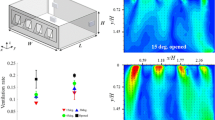Abstract
More than 90% of people’s everyday life is spent indoors, and indoor pollution is responsible for 2.2 million annual deaths on the global scale. The present study investigates the feasibility of natural ventilation for a point source of carbon monoxide in a workshop with side openings. The dynamics of the flow were numerically simulated via a new modified solver in the OpenFOAM software. As the model of a real case, the flow has been configurated to enter from a point source on the floor with insignificant momentum and high buoyancy. The model first was validated using the Haghgoo et al.’s (J Environ Stud 45:725–740, 2019) experiments for the case of having no opening, and then, it was performed for the same flow condition, this time with two openings on the sidewalls. Due to the positive buoyancy, it was observed that in both cases, the CO plume moves upward and disperses in the workshop up to eventually exiting from the roof window. The presence of openings, however, exhibited that is able to improve natural ventilation in indoor space by 30% and considerably reduce CO concentration down to the breathing standards compare to no-opening scenario.









Similar content being viewed by others
References
Abessi O (2018) Brine disposal and management—planning, design, and implementation. In: Sustainable desalination handbook. Butterworth-Heinemann, pp 259–303
CFX-solver (2006) A. N. S. Y. S. Theory guide. Release II
Fischer B, List EJ, Imberger J, Brooks NH (1979) Mixing in inland and coastal waters. Academic Press, New York
Frana K, Zhang JS, Muller M (2013) A numerical simulation of the indoor air flow. Int J Phys Math Sci 7(6):938–943
Ghiaseddin M (2017) Air pollution: sources, effects, and control, 3rd edn. University of Tehran Press, Tehran
Gough HL, Barlow JF, Luo Z, King MF, Halios CH, Grimmond CSB (2020) Evaluating single-sided natural ventilation models against full-scale idealised measurements: impact of wind direction and turbulence. Build Environ 170:106556
Haghgoo A, Abessi O, Rahmani Firouzjaei A (2019) Experimental modeling of the transfer and emission of CO in indoor spaces. J Environ Stud 45:725–740
Haghgoo A (2018) Modeling the diffusion and emission of pollution in indoor spaces. Master Degree Thesis, Babol Noshirvani University of Technology
Holzmann T (2016) Mathematics, numerics, derivations and OpenFOAM®. Holzmann CFD, Loeben, Germany
Jirka G (2004) Integral model for turbulent buoyant jets in unbounded stratified flows. Part I: single round jet. J Environ Fluid Mech 4:1–56
Jones AP (1999) Indoor air quality and health. Atmos Environ 33(28):4535–4564
Karr G, Quivet E, Ramel M, Nicolas M (2022) Sprays and diffusers as indoor air fresheners: exposure and health risk assessment based on measurements under realistic indoor conditions. Indoor Air 32(1):e12923
King MF (2017) Investigating the influence of neighbouring structures on natural Ventilation potential of a full-scale cubical building using time-dependent CFD. J Wind Eng Ind Aerodyn
Lam JC, Chan ALS (2001) CFD analysis and energy simulation of a gymnasium. Building and Environment
Lee JHW, Chu V, Chu VH (2003) Turbulent jets and plumes: a Lagrangian approach, vol 1. Springer
Lende R (1975) A temporary decrease in the ventilatory function of an urban population during an acute increase in air pollution. Bulletin Europeen De Physiopathologie Respiratore. 11:31–43
Levy RJ (2015) Carbon monoxide pollution and neurodevelopment: a public health concern. Neurotoxicol Teratol 49:31–40
Limane A, Fellouah H, Galanis N (2017) Simulation of airflow with heat and mass transfer in an indoor swimming pool by OpenFOAM. Int J Heat Mass Transf 109:862
Limane A, Fellouah H, Galanis N (2015) Thermo-ventilation study by OpenFOAM of the airflow in a cavity with heated floor. Building Simulation
Linden PF (1999) The fluid mechanics of natural ventilation. Annu Rev Fluid Mech 31(1):201–238
Maroni M, Seifert B, Lindvall T (eds) (1995) Indoor air quality: a comprehensive reference book. Elsevier.
Pope SB (2000) Turbulent flows. Cambridge University Press
The American Society of Heating, Refrigerating and Air-Conditioning Engineers, (ASHRAE.org), ASHRAE Standards Strategic Plan.
Saber EM, Chaer I, Gillich A, Ekpeti BG (2021) Review of intelligent control systems for natural ventilation as passive cooling strategy for UK buildings and similar climatic conditions. Energies 14:4388. https://doi.org/10.3390/en14154388
Sakiyama NRM, Mazzaferro L, Carlo JC, Bejat T, Garrecht H (2021) Dataset of the EnergyPlus model used in the assessment of natural ventilation potential through building simulation. Data Brief 34:106753
Sanieinajad M (2004) An introduction to the concepts of turbulent flows and their modeling, 3rd edn. Danesh Negar, Tehran
Reviewing National Ambient Air Quality Standards (NAAQS), USEPA, https://www.epa.gov/indoor-air-quality-iaq/what-average-level-carbon-monoxide-homes
World Health Organization (2010) WHO guidelines for indoor air quality: selected pollutants. World Health Organization, Regional Office for Europe
Acknowledgements
The authors acknowledge the funding support of the Babol Noshirvani University of Technology through grant program No. BNUT/390035/1401.
Author information
Authors and Affiliations
Corresponding author
Ethics declarations
Conflict of interest
The authors declare that they have no conflict of interest.
Additional information
Editorial responsibility: Chenxi Li.
Rights and permissions
Springer Nature or its licensor (e.g. a society or other partner) holds exclusive rights to this article under a publishing agreement with the author(s) or other rightsholder(s); author self-archiving of the accepted manuscript version of this article is solely governed by the terms of such publishing agreement and applicable law.
About this article
Cite this article
Abdi, A., Abessi, O. & Khavasi, E. The effect of opening on the enhancement of natural ventilation in indoor spaces. Int. J. Environ. Sci. Technol. 20, 1875–1886 (2023). https://doi.org/10.1007/s13762-022-04720-9
Received:
Revised:
Accepted:
Published:
Issue Date:
DOI: https://doi.org/10.1007/s13762-022-04720-9




